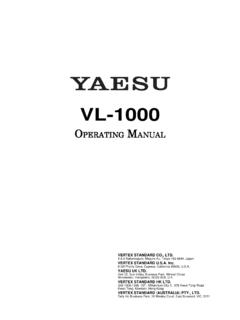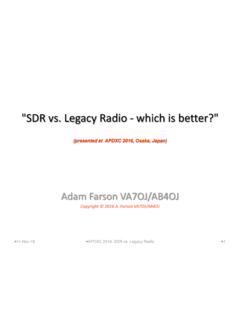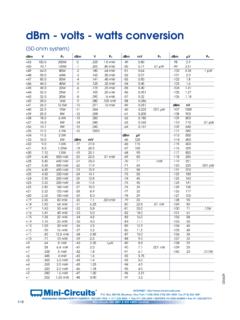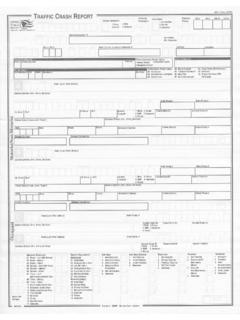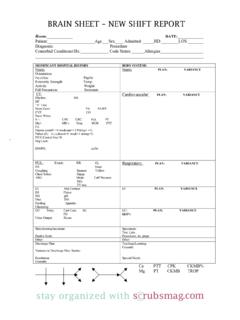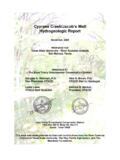Transcription of Test Report: Yaesu FTDX-1200, S/N 3F02051 …
1 1 Test report : Yaesu ftdx -1200, S/N 3F02051 ( loaned by bill trippett W7VP) Adam M. Farson VA7OJ/AB4OJ, 19-21 July 2013 1. Introduction and Scope: The following tests were conducted on the ftdx -1200: A. Receiver tests : 1. MDS (Minimum Discernible Signal): MDS was measured on 20m in CW and SSB modes, to provide a datum point for the DR3 (2-signal 3rd-order IMD dynamic range) test. It was also measured in SSB mode at the NPR (noise power ratio) notch frequencies in the 160, 80, 60 and 40m bands as required for the calculation of NPR. Roofing-filter correction factors were also derived. 2. NPR (noise power ratio) was measured at 1940, 3886, 5340 and 7600 kHz in SSB mode with kHz IF bandwidth.
2 All possible preamp/roofing filter combinations were tested. 3. RMDR (reciprocal mixing dynamic range) was measured at MHz with 2, 3, 5, 10, 20 and 50 kHz offset and IPO. 4. DR3 (2-signal 3rd-order IMD dynamic range) was measured using test signals in the 20m band. Test cases were run at 2, 5, 10 and 20 kHz spacing, with all possible preamp settings. The classic non-subtractive DR3 test method was employed. 5. Image & 1st IF rejection were measured at MHz (the first image of MHz) and at the MHz 1st IF. 6. AGC impulse response and NB efficacy in suppressing this response were tested at MHz, using a pulse generator with 10 ns rise-time.
3 B. Transmitter tests : 1. Power output and autotuner insertion loss were measured at and MHz. 2. CW keying envelope (2a) and keying sidebands (2b) were measured at MHz/100W, using the internal keyer set to 60 wpm. 3. ALC compression tests were performed using voice audio (3a), a 2-tone test signal (3b) and Gaussian noise (3c) applied to the MIC input. The objective was to identify increased IMD caused by ALC action, and to check for ALC overshoot. No overshoot whatsoever was detected. 4. Transmitted 2-tone IMD was measured with a spectrum analyzer at , and MHz. This is a measure of transmitter linearity. 5. Transmitted composite noise was measured with a spectrum analyzer at , and MHz.
4 This is a measure of LO phase noise plus the noise contribution of downstream stages in the transmitter. 2. Receiver tests and Results: Test A1: MDS (Minimum Discernible Signal): This is a measure of ultimate receiver sensitivity. In this test, MDS is defined as the RF input power which yields a 3 dB increase in the receiver noise floor, as measured at the audio output. 2 Test Conditions: ATT off, DNR off, NB off, DNF off, Notch off, Contour off. AGC Slow. Roofing filter: 15 kHz (R15). Roofing filter correction factors were measured and applied to NPR results, as follows: R15: 0 dB. R6: +1 dB. R3: +2 dB. Test results are in Table 1.
5 Table 1: MDS. MDS dBm Freq. kHz Mode IF BW IPO AMP 1 AMP 2 14100 CW 500 Hz -120 -132 -139 USB kHz -114 -127 -134 3600 CW 500 Hz -122 -135 -139 LSB kHz -118 -131 -135 50100 CW 500 Hz -120 -132 -140 USB kHz -115 -128 -134 1940 LSB kHz -113 -125 3886 LSB kHz -115 -127 -133 5340 USB kHz -117 129 -134 7600 LSB kHz -117 -128 -134 Test A2: Reciprocal mixing dynamic range (RMDR): In this test, a strong "undesired" signal is injected into the receiver's RF input at a fixed offset f from the operating frequency. The RF input power Pi is increased until the receiver noise floor increases by 3 dB, as measured at the audio output.
6 RMDR is the difference between this RF input power and measured MDS. The test is run with preamp off. The higher the RMDR value, the better. If RMDR is lower, than DR3, reciprocal mixing noise is the dominant impairment and vice versa. Test Conditions: f0 = 14100 kHz, CW mode, 500 Hz filter, preamp off (IPO), ATT off, DNR off, NB off, DNF off, Notch off, Contour off. AGC Slow, offset relative to virtual carrier. Roofing filter: 3 kHz (R3). RMDR in dB = input power MDS (both in dBm). Test results are in Table 2. Table 2: Reciprocal Mixing Dynamic Range RMDR f kHz Pi dBm RMDR dB 2 -38 82 3 -34 86 5 -30 90 10 -23 97 20 -17 103 50 -14 106 Test A3: DR3 (2-signal 3rd-order IMD dynamic range): The purpose of this test is to determine the range of signals which the receiver can tolerate while essentially generating no spurious responses.
7 In this test, two signals of equal amplitude Pi and separated by a known offset f are combined and injected into the receiver input. If the test signal frequencies are f1 and f2, the offset f = f2 - f1 and the 3rd-order intermodulation products appear at (2 f2 - f1) and (2 f1 - f2). 3 The two test signals are combined in a passive hybrid combiner and applied to the receiver input via a step attenuator. The receiver is tuned to the upper and lower 3rd-order IMD products (2f2 f1 and 2f1 - f2 respectively) which appear as a 700 Hz tone in the speaker. The per-signal input power level Pi is adjusted to raise the noise floor by 3 dB, IMD products at MDS.
8 The Pi values for the upper and lower products are recorded and averaged. Note: If the audio output drops by less than 3 dB when one of the test signals is removed, the measurement is noise-limited (indicated by NL in Table 3.) In addition, the test signal frequencies can be varied slightly to verify that the measured IMD products are genuine and not spurs. DR3 = Pi - MDS. Calculated IP3 = ( * DR3) - MDS Test Conditions: f1 = 14010 kHz, f2 = (f1 + f ) kHz, 500 Hz CW, roofing filter 3 kHz (R3), ATT off, DNR off, NB off, DNF off, Notch off, Contour off. AGC Slow. CW Pitch = 700 Hz. DR3 in dB; IP3 in dBm. NL = reciprocal mixing noise limited (IMD + reciprocal mixing).
9 A quick check with roofing filter 6 kHz (R6) showed a slight drop in DR3 ( 1 dB). Test results are in Table 3. Table 3: DR3 and IP3 f1 kHz f2 kHz f kHz MDS dBm Preamp Pi dBm DR3 dB IP3 dBm NL 14010 14012 2 -120 IPO -41 79 Y 14010 14012 2 -132 AMP 1 -54 78 -15 Y 14010 14012 2 -139 AMP 2 -65 74 -28 Y 14010 14015 5 -120 IPO -39 81 + 14010 14020 10 -120 IPO -26 94 +21 14010 14030 20 -120 IPO -25 95 + Test A4: Noise Power Ratio (NPR): An NPR test was performed, using the test methodology described in detail in Ref. 1. The noise-loading source used for this test was a noise generator fitted with the following selectable filter pairs (bandstop & band-limiting filters): Table 4: Noise Generator Filter Pairs Bandstop filter f0 kHz Band limiting filter kHz BRF kHz BWR dB 1940 60 - 2048 1985 3886 60 - 4100 4037 5340 60 - 5600 5537 7600 316 - 8100 7781 Bandstop filter stopband: depth 100 dB, width 3 kHz.
10 4 The noise loading PTOT was increased until the audio level measured at the external speaker jack increased by 3 dB. PTOT was read off the attenuator scale on the noise generator, and NPR was then calculated using the formula NPR = PTOT - BWR - MDS where PTOT = total noise power in dBm for 3 dB increase in audio output BWR = bandwidth ratio = 10 log10 (BRF/BIF) BRF = RF bandwidth or noise bandwidth in kHz (noise source band-limiting filter) BIF = receiver IF filter bandwidth in kHz MDS = minimum discernible signal (specified at BIF), measured prior to NPR testing Test Conditions: Receiver tuned to bandstop filter center freq.




